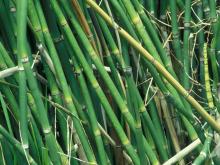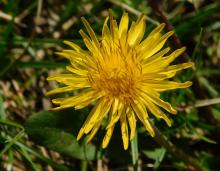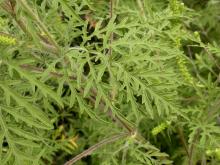Wildflowers, Grasses and Other Nonwoody Plants
Media

Species Types
Scientific Name
Equisetum (3 spp. in Missouri)
Description
Horsetails, or scouring rushes, are in the genus Equisetum. They’re easy to recognize with their jointed, hollow stems. Like ferns, they reproduce via spores instead of flowers and seeds.
Media

Species Types
Scientific Name
Asplenium platyneuron
Description
Ebony spleenwort is a common forest-floor fern with wiry, shiny, dark brown leaf stalks and a ladderlike series of dark green, narrowly oblong leaflets.
Media

Species Types
Scientific Name
Cystopteris protrusa (formerly C. fragilis var. protrusa)
Description
Lowland brittle fern, also called southern fragile fern, is an easily recognized species. It’s a common springtime sight in moist forest soils.
Media

Species Types
Scientific Name
Botrypus virginianus (syn. Botrychium virginianum)
Description
Rattlesnake fern rises from the ground with a single stalk. A lacy-cut, bright green fern leaf is stalkless at its tip. At the same joint, a single upright stalk arises that bears clusters of tiny ball-shaped spore cases.
Media

Species Types
Scientific Name
Botrychium dissectum (syn. Sceptridium dissectum)
Description
Cut-leaf grape fern appears as a single, leathery fern leaf. Another stalk grows upward from the base and bears yellowish spore cases that resemble tiny bunches of grapes. The fleshy leaves turn reddish brown in fall.
Media

Species Types
Scientific Name
Taraxacum officinale
Description
The common dandelion is a well-known common weed of lawns, roadsides, and other disturbed places. Originally from Europe, it occurs nearly worldwide.
Media

Species Types
Scientific Name
Chenopodium album
Description
Lamb’s quarters won’t win any beauty contests for its flowers, but it merits an award for being both a common garden weed as well as a nutritious leafy green valued around the world.
Media

Species Types
Scientific Name
Viola viarum
Description
The leaf blades of plains, or wayside violet are highly variable, and the plant produces differently shaped leaves as the season progresses. It’s quite similar to cleft violet, but the leaves are smooth and hairless.
Media

Species Types
Scientific Name
Helenium virginicum
Description
Virginia sneezeweed is the rarest of Missouri’s four sneezeweeds. A state endangered and federally threatened species, it occurs in about 60 sites in our southern Ozark counties, primarily in boggy, sinkhole pond habitats.
Media

Species Types
Scientific Name
Ambrosia artemisiifolia
Description
Common ragweed is instantly recognizable by its ornate, 2–3 times pinnately lobed, hairy leaves. You’ve probably seen it many times and wondered what it was.
See Also
About Wildflowers, Grasses and Other Nonwoody Plants in Missouri
A very simple way of thinking about the green world is to divide the vascular plants into two groups: woody and nonwoody (or herbaceous). But this is an artificial division; many plant families include some species that are woody and some that are not. The diversity of nonwoody vascular plants is staggering! Think of all the ferns, grasses, sedges, lilies, peas, sunflowers, nightshades, milkweeds, mustards, mints, and mallows — weeds and wildflowers — and many more!





















